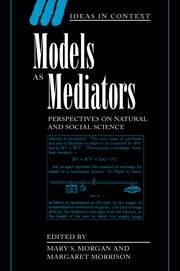Book contents
- Frontmatter
- Contents
- List of contributors
- Preface
- 1 Introduction
- 2 Models as mediating instruments
- 3 Models as autonomous agents
- 4 Built-in justification
- 5 The Ising model, computer simulation, and universal physics
- 6 Techniques of modelling and paper-tools in classical chemistry
- 7 The role of models in the application of scientific theories: epistemological implications
- 8 Knife-edge caricature modelling: the case of Marx's Reproduction Schema
- 9 Models and the limits of theory: quantum Hamiltonians and the BCS models of superconductivity
- 10 Past measurements and future prediction
- 11 Models and stories in hadron physics
- 12 Learning from models
- Index
4 - Built-in justification
Published online by Cambridge University Press: 10 March 2010
- Frontmatter
- Contents
- List of contributors
- Preface
- 1 Introduction
- 2 Models as mediating instruments
- 3 Models as autonomous agents
- 4 Built-in justification
- 5 The Ising model, computer simulation, and universal physics
- 6 Techniques of modelling and paper-tools in classical chemistry
- 7 The role of models in the application of scientific theories: epistemological implications
- 8 Knife-edge caricature modelling: the case of Marx's Reproduction Schema
- 9 Models and the limits of theory: quantum Hamiltonians and the BCS models of superconductivity
- 10 Past measurements and future prediction
- 11 Models and stories in hadron physics
- 12 Learning from models
- Index
Summary
INTRODUCTION
In several accounts of what models are and how they function a specific view dominates. This view contains the following characteristics. First, there is a clear-cut distinction between theories, models and data and secondly, empirical assessment takes place after the model is built. In other words, the contexts of discovery and justification are disconnected. An exemplary account can be found in Hausman's The Separate and Inexact Science of Economics (1992). In his view, models are definitions of kinds of systems, and they make no empirical claims. Although he pays special attention to the practice of working with a model – i.e. conceptual exploration – he claims that even then no empirical assessment takes place. ‘Insofar as one is only working with a model, one's efforts are purely conceptual or mathematical. One is only developing a complicated concept or definition’ (Hausman 1992, 79). In Hausman's view, only theories make empirical claims and can be tested. Above that, he does not make clear where models, concepts and definitions come from. Even in Morgan's account ‘Finding a Satisfactory Empirical Model’ (1988), which comes closest to mine and will be dealt with below, she mentions a ‘fund’ of empirical models of which the most satisfactory model can be selected. This view in which discovery and justification are disconnected is not in accordance with several practices of mathematical business-cycle model building. What these practices show is that models have to meet implicit criteria of adequacy, such as satisfying theoretical, mathematical and statistical requirements, and be useful for policy.
- Type
- Chapter
- Information
- Models as MediatorsPerspectives on Natural and Social Science, pp. 66 - 96Publisher: Cambridge University PressPrint publication year: 1999
- 98
- Cited by

